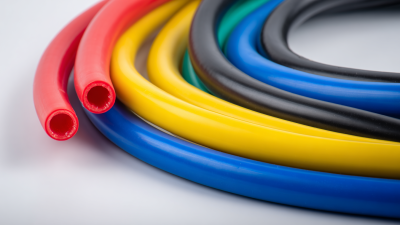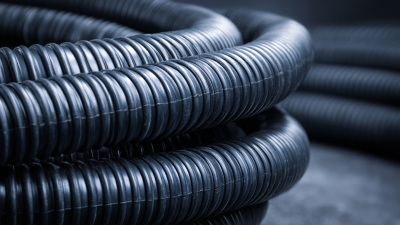In the pursuit of optimal performance in various applications, the choice of materials is paramount, and Fluorosilicone Hose has emerged as a popular option due to its exceptional resistance to harsh chemicals and high temperatures. However, as industries evolve and new technologies are developed, the need for exploring alternatives becomes increasingly pressing. This blog delves into the world of fluorosilicone hose alternatives, examining the benefits and limitations of various options available in the market. By analyzing factors such as durability, flexibility, and application suitability, we aim to provide valuable insights that will help engineers and decision-makers find the best fit for their unique requirements.

Whether you're seeking solutions for aerospace, automotive, or industrial applications, understanding the range of alternatives to Fluorosilicone Hose could lead to improved performance and cost-efficiency in your projects. Join us as we explore the innovative materials that can effectively meet your operational demands.
When it comes to selecting materials for specific applications, understanding the unique properties and advantages of fluorosilicone hoses is crucial. Fluorosilicone rubber, known for its excellent resistance to high temperatures and chemical exposure, is widely utilized in various industries, including automotive, aerospace, and manufacturing. The global fluorosilicone rubber market reached an estimated USD 7.62 billion in 2023, reflecting a growing recognition of its benefits. As the market is projected to expand at a CAGR of 6.3% from 2024 to 2030, it’s clear that businesses are increasingly looking for alternatives that meet their specific needs without sacrificing performance.
Key considerations when evaluating fluorosilicone hoses for your application include the operating environment, temperature range, and chemical compatibility. Choosing the right alternative requires a thorough understanding of the demands of the application at hand. For instance, while fluorosilicone hoses excel in extreme conditions, factors such as flexibility, durability, and the potential for alternative materials should also be taken into account. With the burgeoning market for fluorosilicone rubber, companies have more options than ever to find materials that align perfectly with their operational requirements.
Fluorosilicone hoses offer excellent resistance to extreme temperatures, fuels, and chemicals, making them a popular choice in various industries. However, there are several alternatives that can also provide valuable benefits depending on the specific requirements of your application. By exploring these alternatives, one can have more flexibility in material selection, potentially leading to cost savings and enhanced performance.
One notable alternative is silicone rubber hose, which shares many of the temperature and chemical resistance properties of fluorosilicone but at a lower cost. These hoses are lightweight and flexible, making them ideal for applications that require significant movement or bending. Additionally, thermoplastic elastomer (TPE) hoses are gaining traction for their durability and ease of handling; they exhibit excellent resistance to abrasion and can be tailored to meet particular application demands. By assessing these alternatives, you can identify the best fit for your needs, ensuring efficiency and reliability in your operations.
When considering alternatives to fluorosilicone hoses, it’s crucial to explore options tailored to specific industrial needs. According to a recent report by Grand View Research, the global industrial hoses market is projected to reach $15.91 billion by 2025, highlighting the demand for reliable materials across various sectors. For applications requiring high resistance to heat and chemicals, silicone rubber hoses stand out as a suitable substitute, boasting a temperature range from -50°C to 200°C.
Additionally, polyurethane hoses have gained traction in industries such as automotive and food processing due to their flexibility and abrasion resistance. Research from MarketsandMarkets indicates that the polyurethane market is expected to reach $68.6 billion by 2025, reflecting its growing adoption in hose manufacturing. For environments prone to extreme conditions, PTFE hoses provide excellent chemical resistance and can handle a wide temperature range, making them ideal for the pharmaceutical and chemical industries. As industries continue to evolve, selecting the right hose material becomes imperative for operational efficiency and safety.

When selecting the right hose material for your specific needs, it's essential to consider several key factors that will influence performance and longevity. Understanding the environmental conditions that the hose will be exposed to, such as temperature fluctuations, chemical exposure, and pressure requirements, is crucial. For instance, fluorosilicone hoses are known for their excellent resistance to high temperatures and aggressive chemicals. However, there are various alternatives that can offer similar or even enhanced properties for specialized applications.
Another important tip is to evaluate the flexibility and bend radius of the hose material. Depending on your installation space and movement requirements, a more flexible option may be necessary to accommodate tight turns without compromising flow efficiency. Materials like silicone and thermoplastic elastomers can provide the necessary flexibility, while still being resistant to degradation. Always consider the specific application requirements and the operational environment to ensure you select a hose that won't just meet, but exceed expectations.
| Material Type | Temperature Range (°C) | Chemical Resistance | Flexibility | Pressure Rating (PSI) |
|---|---|---|---|---|
| Fluorosilicone | -60 to 200 | Excellent | Good | 150 |
| Silicone | -50 to 200 | Good | Excellent | 100 |
| EPDM | -40 to 120 | Good | Moderate | 90 |
| PTFE | -200 to 260 | Excellent | Moderate | 300 |
| Nitrile | -40 to 100 | Fair | Good | 130 |
When it comes to maintaining and optimizing the performance of fluorosilicone hoses, understanding the specific needs of your application is crucial. Recent industry data indicates that proper maintenance can extend hose lifespan by up to 35%, making it a priority for operators in high-demand fields such as aerospace and automotive. Regular inspection for wear and tear, along with adherence to recommended cleaning procedures, can significantly reduce the risk of premature failure — a common issue in environments exposed to harsh chemicals or extreme temperatures.

Moreover, performance optimization goes hand in hand with selecting the right alternatives to fluorosilicone hoses. According to a 2022 report by the International Rubber Study Group, selecting the appropriate material can enhance resistance to fuel permeation and improve overall elasticity. For instance, using a thermoplastic elastomer (TPE) as a substitute has shown to provide a 20% improvement in flexibility while maintaining compatibility with aggressive fluids, therefore increasing the longevity of the hose. By focusing on these key areas of maintenance and performance enhancement, organizations can not only ensure operational efficiency but also safeguard their investments in critical components.






